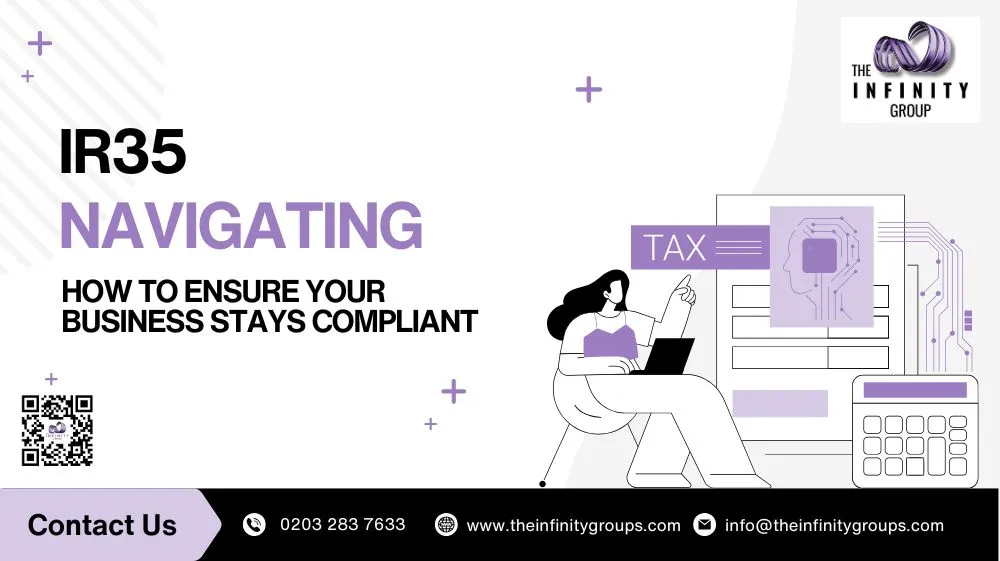Introduction
Navigating IR35 is essential for businesses that engage self-employed workers and contractors. IR35 is a crucial piece of UK tax legislation introduced by HMRC in 2000 to prevent tax avoidance by individuals providing services through intermediaries, such as personal service companies (PSCs), while operating similarly to employees.
For businesses hiring contractors, navigating IR35 compliance correctly helps avoid penalties, unexpected tax liabilities, and reputational risks. This guide will provide insights to ensure your business stays compliant.
Navigating IR35:Understanding IR35 and Its Implications
IR35 applies when a contractor is considered a “disguised employee,” meaning they work under conditions similar to that of an employee rather than a genuine self-employed individual. The key factors that determine IR35 status include:
- Control: Does the client control how, when, and where the contractor works?
- Substitution: Can the contractor send a substitute to perform their duties?
- Mutuality of Obligation (MOO): Is the client obligated to provide work, and is the contractor required to accept it?
If a contractor is deemed inside IR35, they must pay National Insurance Contributions (NICs) and income tax like an employee, but without the employment benefits.
Who is Responsible for IR35 Compliance?
Before the IR35 reform in April 2021, contractors were responsible for determining their IR35 status. However, for medium and large private sector businesses, as well as public sector organisations, the responsibility now falls on the client hiring the contractor.
Small businesses are exempt from the changes and can continue allowing contractors to assess their IR35 status. HMRC defines a small business as one that meets two of the following criteria:
- Annual turnover of less than £10.2 million
- Balance sheet total of less than £5.1 million
- Fewer than 50 employees
Steps to Ensure Your Business Stays IR35 Compliant
1. Navigating IR35: Conduct Employment Status Assessments
Each contractor’s engagement should be reviewed carefully to determine whether they fall inside or outside IR35. Businesses can use HMRC’s Check Employment Status for Tax (CEST) tool or seek independent legal advice.
2. Review Contracts and Working Practices
Ensure that contracts reflect actual working arrangements. Key points to consider:
- Clearly define deliverables and avoid clauses that imply an employer-employee relationship.
- Avoid excessive control over contractors’ schedules or day-to-day activities.
- Include a substitution clause, allowing the contractor to send a qualified replacement.
3. Maintain Proper Documentation
Keep detailed records of:
- IR35 assessments and justifications
- Contracts and agreed terms
- Working arrangements that show genuine self-employment
Proper documentation can protect your business in case of an HMRC investigation.
4. Consider Engaging IR35 Specialists
Due to the complexity of IR35, many businesses opt for specialist IR35 consultancies or payroll services that ensure compliance while reducing administrative burdens.
5. Use Compliant Payment Structures
If a contractor falls inside IR35, businesses can:
- Deduct taxes and NICs before payment
- Engage them through umbrella companies
- Offer permanent employment if long-term engagement is required
6. Communicate Clearly with Contractors
Ensure transparency with contractors regarding IR35 determinations. Provide a Status Determination Statement (SDS) that explains the reasoning behind their IR35 status. Contractors have the right to challenge an IR35 assessment if they disagree.
7. Regularly Review IR35 Policies
IR35 rules and interpretations evolve, so businesses should conduct periodic reviews to ensure ongoing compliance. Keeping up with the latest HMRC guidance and case law is essential.
Penalties for Non-Compliance
Failing to comply with IR35 can result in significant financial consequences, including:
- Unpaid taxes and NICs
- Fines and interest on overdue payments
- Potential HMRC investigations
Proactively addressing IR35 compliance minimises these risks and ensures smooth contractor engagements.
Conclusion
IR35 compliance is essential for businesses that hire contractors in the UK. By understanding IR35 rules, conducting employment status assessments, and implementing best practices, companies can navigate IR35 legislation effectively. Engaging legal experts or payroll providers can further safeguard against non-compliance risks. The Infinity Group will guide you with all the necessary information to ensure compliance.
Staying informed and proactive about IR35 will protect your business from financial and legal repercussions while ensuring fair treatment of contractors.
Frequently Asked Questions (FAQs)
1. What is IR35 and why was it introduced?
IR35 is a UK tax legislation designed to prevent tax avoidance by individuals working as contractors but operating similarly to full-time employees. It ensures that such individuals pay the correct taxes and NICs.
2. How do I determine if a contractor falls inside or outside IR35?
The determination depends on factors such as control, substitution, and mutuality of obligation. You can use HMRC’s CEST tool or seek professional legal advice for accurate assessment.
3. What happens if my business misclassifies a contractor under IR35?
If a contractor is wrongly classified as outside IR35, your business may be liable for unpaid taxes, NICs, fines, and potential legal penalties from HMRC.
4. Are small businesses exempt from IR35 rules?
Yes, small businesses (as defined by HMRC) are exempt from the April 2021 IR35 reforms and can allow contractors to self-assess their IR35 status.
5. How can I reduce the risk of IR35 non-compliance?
To minimise risks, conduct employment status assessments, maintain proper documentation, seek expert advice, and regularly review contracts and working practices.

